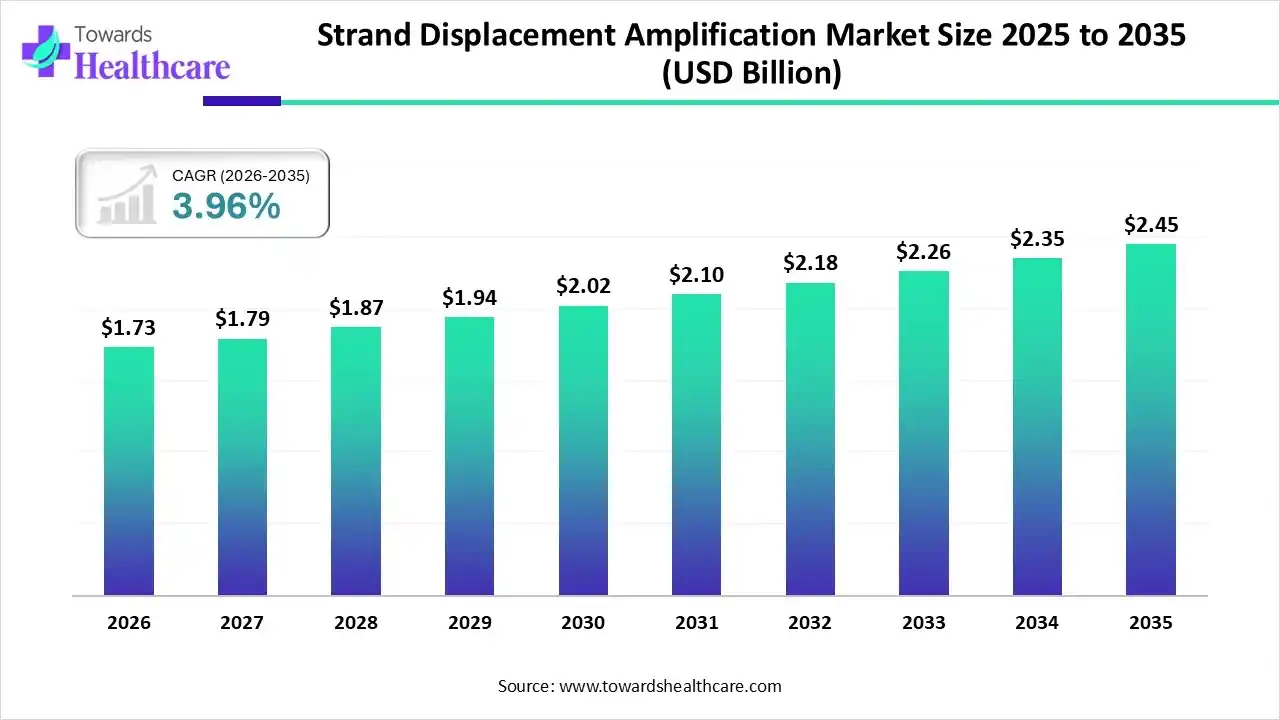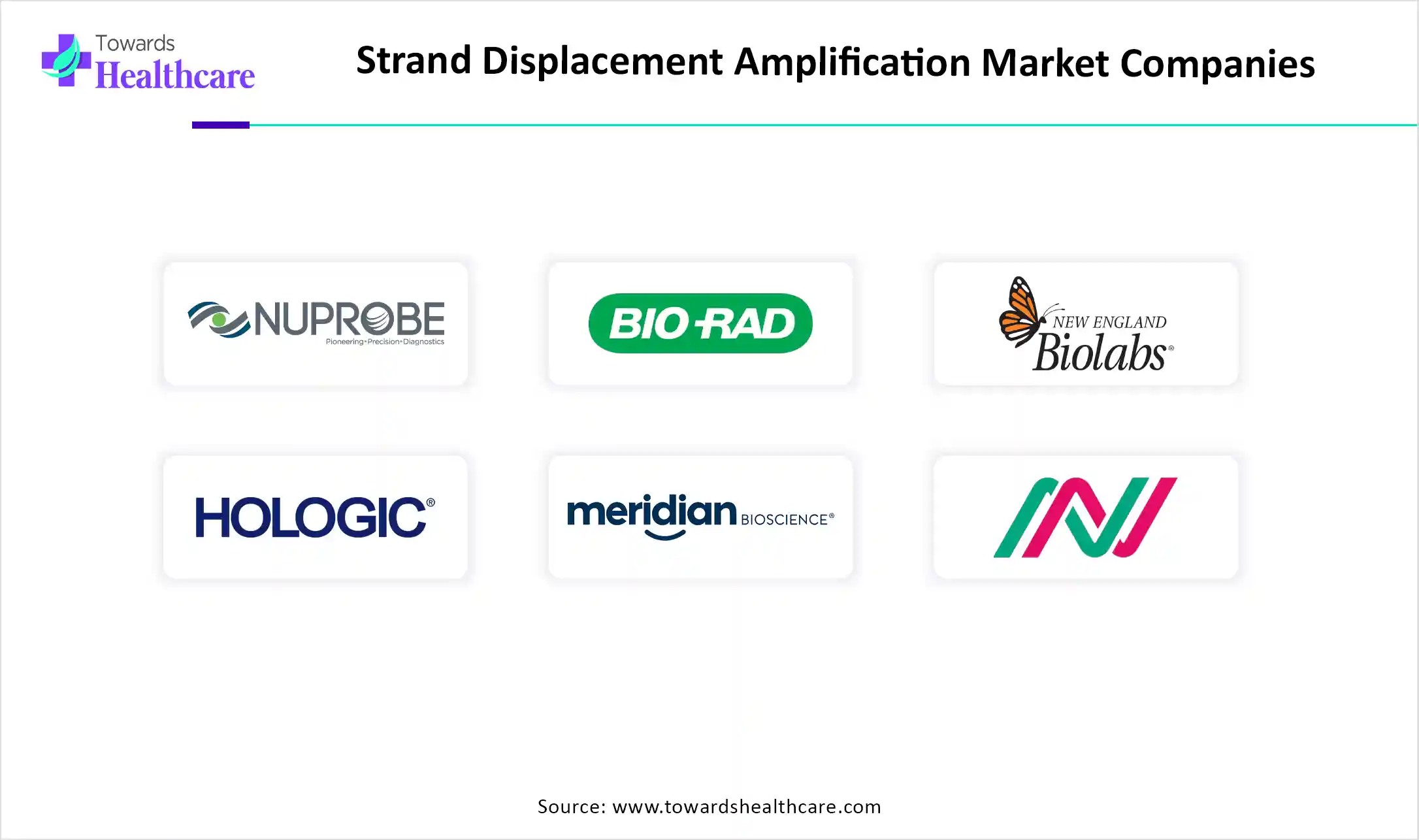
The strand displacement amplification (SDA) market size touched US$ 1.66 billion in 2025, with expectations of climbing to US$ 1.73 billion in 2026 and hitting US$ 2.45 billion by 2035, driven by a CAGR of 3.96% over the forecast period.

The increasing role of strand displacement amplification (SDA) in facilitating quicker and more precise diagnostic testing is responsible for the market's global significance. SDA offers a much-needed substitute for improving the sensitivity and specificity of diagnostic tests, which is crucial given the rising demand for healthcare solutions worldwide, particularly in developing nations. It responds to the growing demand for easily accessible and reasonably priced diagnostic technologies, especially in areas with restricted access to cutting-edge laboratory facilities. Advanced diagnostic techniques like SDA are becoming more and more necessary as the prevalence of infectious diseases, chronic illnesses, and genetic abnormalities rises globally.
Before detection, a DNA target sequence can be amplified in vitro using the isothermal Strand Displacement Amplification (SDA) approach. The total efficiency of amplification is increased by the new approach. The most attractive feature of SDA is that, in contrast to PCR and the ligase chain reaction, which both need instrumented temperature cycling, it just needs one temperature. SDA uses fewer enzymes and a more straightforward process than isothermal, transcription-based methods. Because ribonuclease activity does not contaminate SDA, it may also be more resilient than transcription-based procedures.
Artificial intelligence (AI) has become essential for identifying sequencing errors and sorting through enormous amounts of data in the interpretation of genetic test results. Artificial intelligence (AI) has promise for improving the speed, accuracy, and efficiency of data analysis for most genetic tests. Small changes might be swiftly detected with AI's assistance, accelerating investigation, diagnosis, and the development of tailored treatments.
Point-of-Care Testing Demand
One of the primary drivers of the SDA sector is the increasing need for point-of-care testing (POCT). Because of their high sensitivity and fast turnaround time, SDA techniques are particularly well-suited for POCT applications, allowing medical professionals to make decisions swiftly. The increasing prevalence of infectious diseases and genetic disorders is also driving investments in diagnostic technologies.
Inability to Efficiently Amplify Long Target
The largest disadvantage of SDA is, by far, its inability to efficiently amplify long target sequences. Until this defect is corrected, the diagnostic lab will be responsible for SDA and the ligase chain reaction. These days, SDA cannot compete with PCR in scientific applications such as gene sequence isolation.
Investment Opportunities
The SDA business provides a variety of investment choices primarily because of market development, mergers and acquisitions, and the emergence of new markets. One of the key elements drawing investment to the SDA sector is the robust market development, which is being propelled by the growing need for molecular diagnostic technologies globally. It is projected that as academics and medical professionals explore novel approaches to enhance diagnostic accuracy, the application of SDA technology will progressively grow.
By product type, the reagents & consumables segment dominated the strand displacement amplification (SDA) market in 2024. DNA is amplified at a steady temperature using strand displacement amplification (SDA), which requires particular supplies and chemicals. The required components include an exonuclease, dNTPs, strand displacement DNA polymerase, a nicking endonuclease, and two sets of primers: outside "bumper" primers and interior SDA primers. Reaction buffer and DNA template are consumables.
By product type, the instruments segment is estimated to grow at the fastest CAGR in the strand displacement amplification (SDA) market during the predicted period. Various instruments are used in SDA techniques, which are different from traditional PCR. Instruments are an essential part of the SDA process as they are important in maintaining ideal conditions for the SDA reactions. With technological advancements and the integration of AI and machine learning, these systems can be enhanced to provide better results.
By application, the tuberculosis segment held the largest share of the strand displacement amplification (SDA) market in 2024. In 2023, 1.25 million people died from tuberculosis (TB), including 161,000 persons with HIV. TB is probably going to be the leading infectious agent-related cause of death globally once more. In 2023, 10.8 million people worldwide, 6.0 million men, 3.6 million women, and 1.3 million children, were predicted to have had TB.
By application, the cancer segment is anticipated to grow at the fastest rate in the strand displacement amplification (SDA) market during 2025-2034. By 2050, there will be over 35 million new cases of cancer, a 77% increase from the projected 20 million cases in 2022. Changes in risk factor exposure, many of which are connected to socioeconomic development, as well as population growth and aging, are the main causes of the rapidly rising global cancer burden. Even though air pollution is still a significant contributor to environmental risk factors, obesity, alcohol use, and tobacco use are the primary causes of the rising incidence of cancer.
By end-user, the diagnostics centers segment held the largest share of the strand displacement amplification (SDA) market in 2024. SDA is mainly a diagnostic technique due to which it is highly utilized in diagnostics centers. Diagnostic centers are well equipped and have highly skilled professionals to conduct the diagnostic services. These centers specialize in provided high quality services due to which they are preferred over other end-user. Apart from this, various healthcare organizations associated with diagnostic centers in order to utilize their services.
By end-user, the hospitals & clinics segment is estimated to grow at the highest rate in the strand displacement amplification (SDA) market during the upcoming timeframe. Hospitals and clinics usually rely on diagnostic centers for their services but many hospitals and clinics are focusing on developing their own dianostic centers in order to increase the efficiency of patient care. As more and more pateints are going to need SDA services, hospitals and clinics are going to develop their diagnostic centers.
North America dominated the strand displacement amplification (SDA) market in 2024. Due to the growing number of elderly people, the prevalence of chronic illnesses, and the existence of major market participants in the area. The need for lateral flow tests to identify infectious illnesses, including hepatitis C, RSV, and HIV, is also anticipated to increase due to their increasing incidence.
The U.S. is leading the market in the North American region due to the rising prevalence of tuberculosis and cancer, which use SDA as a diagnosis method. For instance, with non-melanoma skin cancer excluded, at least 40% of newly diagnosed cancers in U.S. adults, or more than 811,000 cases in 2025, may be avoidable, including the 19 percent of cancers are caused by cigarette smoking, eight percent are caused by being overweight, and five percent are caused by consuming alcohol. It is projected that, excluding non-melanoma skin cancers, more than 2 million new cases of cancer will be diagnosed in the U.S. in 2025, and that more than 618,000 people will die from the disease. Furthermore, with 900 new cases reported and 100 fatalities every day, tuberculosis is among the most infectious illnesses in the Americas.
Canada is right behind the U.S. due to growing investments and the rising prevalence of chronic conditions. For example, in 2025, the government is dedicated to creating a TB Elimination Strategy for Canada in collaboration with provincial and territorial partners, Indigenous rights holders, and others. In addition, Canada has committed to achieving its domestic goals, which include eradicating tuberculosis (TB) among Inuit in Inuit Nunangat by 2030, reducing the incidence of active TB among Inuit in Inuit Nunangat by 50% (compared to 2016 rates) by 2025, and eliminating TB nationwide by 2035.
Asia Pacific is estimated to host the fastest-growing strand displacement amplification (SDA) market during the forecast period. In the Asia Pacific area, strand displacement technology has advanced significantly in recent years, becoming more sensitive, specific, and user-friendly. Because of this, strand displacement amplification is becoming more and more attractive to researchers and physicians in the Asia Pacific area, which will propel the market's future growth in this region.
China continues to carry a heavy burden of TB, with an incidence rate of 52 cases per 100,000 people and a projected 741,000 new cases recorded in 2023, or 6.8% of all cases globally. To proactively address these concerns, the National Bureau of Disease Prevention and Control has developed the "National TB Prevention and Control Plan (2024−2030)" in collaboration with eight other ministries and commissions. It outlines a calculated strategy for China's TB control. Moreover, 25% of all cancer-related fatalities worldwide occur in China. Cancer prevention and management have become a major health issue in China.
According to the ICMR's National Cancer Registry Programme (NCRP), there will be 15,69,793 cancer cases nationwide in 2025. According to the International Agency for Research on Cancer's (IARC) Global Cancer Observatory, India's cancer incidence is predicted to rise to 22,18,694 cases by 2040. The TB Free India campaign, started by Prime Minister Narendra Modi, aims to eradicate tuberculosis by 2025, five years before the UN Sustainable Development Goals are due.
Europe is expected to grow significantly in the strand displacement amplification (SDA) market during the forecast period. Strong legislative support, rising demand for molecular testing technologies, and the creation of rapid diagnostic platforms are driving the expansion of the SDA industry in Europe. Expanded use of SDA in the areas of healthcare and food safety by countries such as the UK, France, and Germany.
While the loss in life expectancy caused by cancer is expected to be close to the EU norm, the burden of cancer as a proportion of health spending in Germany is expected to be 9.1% between 2023 and 50, which is much higher than the EU average. To develop a long-term, evidence-based cancer prevention strategy for Germany, DKFZ and German Cancer Aid will organize a National Cancer Prevention Summit in the middle of 2025.
During January through March (quarter 1) of 2025, 1,266 people had a TB diagnosis, a 2.1% increase over the same period in 2024. Enhancing TB prevention, detection, and control is the goal of England's upcoming 2026–2031 TB action plan. The requirements of individuals affected by tuberculosis and TB care will be given top priority in the national action plan.
The Middle East & Africa are expected to grow at a considerable CAGR in the upcoming period. The growing demand for point-of-care diagnostics and the burgeoning biotechnology sector bolster market growth. Government organizations launch initiatives to create awareness about early diagnosis and screening of chronic disorders. The increasing investments and collaborations among key players foster market growth. Healthcare organizations and biotech companies increasingly adopt advanced technologies to develop advanced diagnostics.
The UAE government launched the “National Policy for Empowering People of Determination” that focuses on health and rehabilitation, education, vocational rehabilitation and employment, outreach, social protection, and culture & sports. This promotes early detection and diagnosis of impairments.
In South Africa, an estimated 178,000 new cases of HIV were reported in 2023/2024. The total number of people living with HIV surpassed 8 million in 2024, accounting for 12.8% of the total population. Approximately 24% of all TB cases in the world were from Africa in 2023, resulting in 2.55 million cases.

In February 2024, according to Peter Foley, founder and CEO of LetsGetChecked, myGeneticScreen uses genomics to its full potential and has the potential to revolutionize the way we diagnose, prevent, and treat a wide range of illnesses. We think that the key to improved health is information, and with the launch of myGeneticScreen, we are opening up important genetic insights and paving the way for a day when people take charge of their own proactive health management path. (Source - Businesswire)
By Product Type
By Application
By End-User
By Region